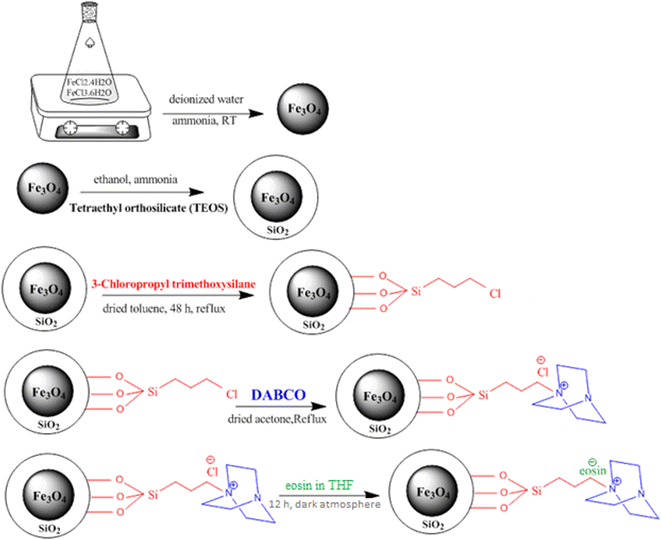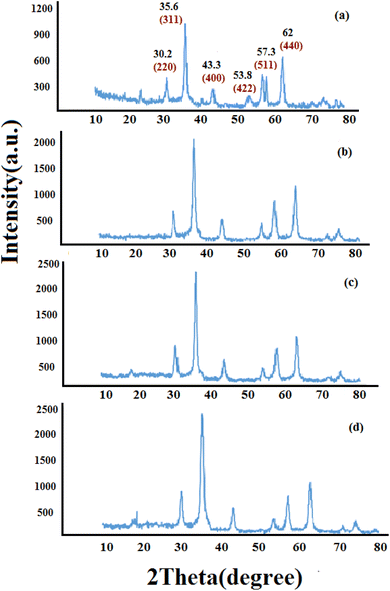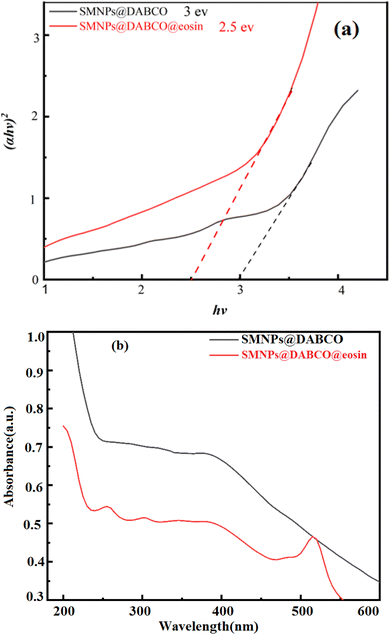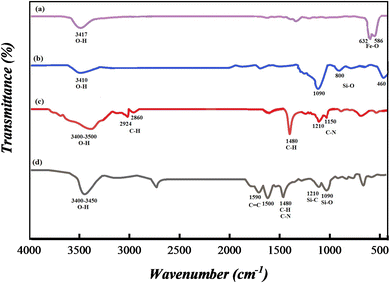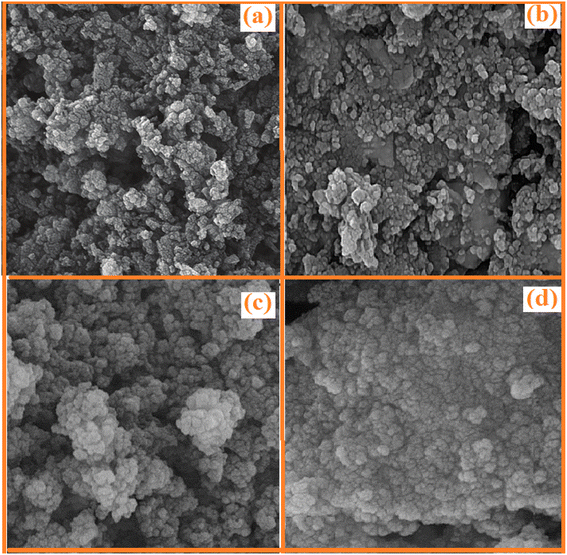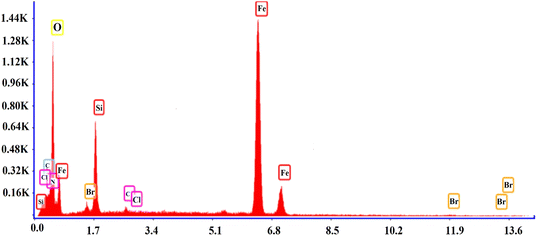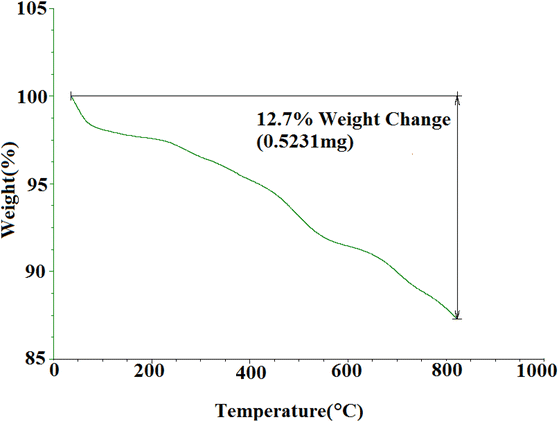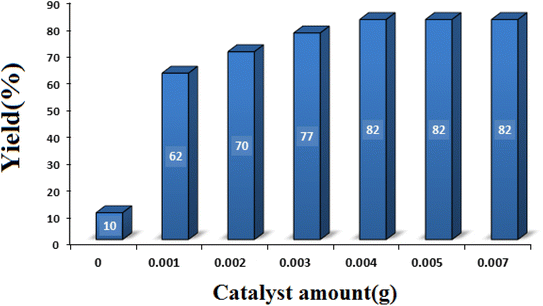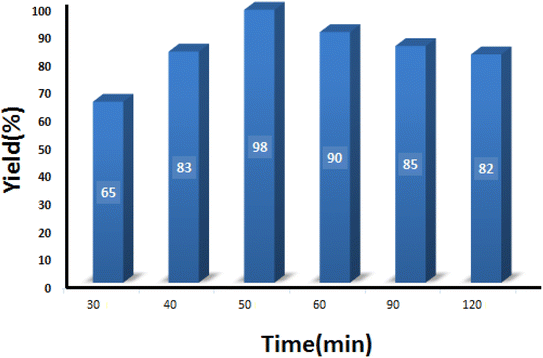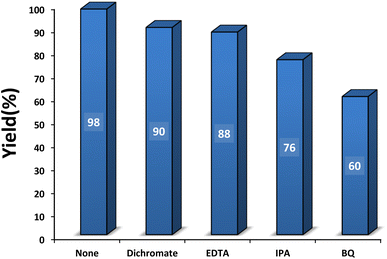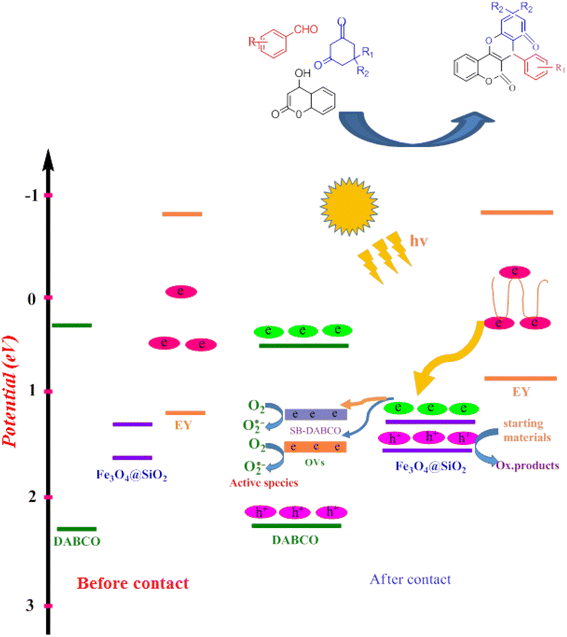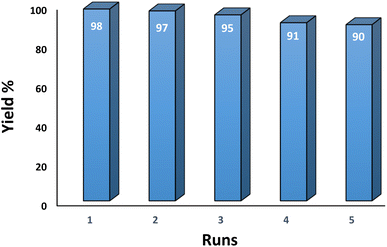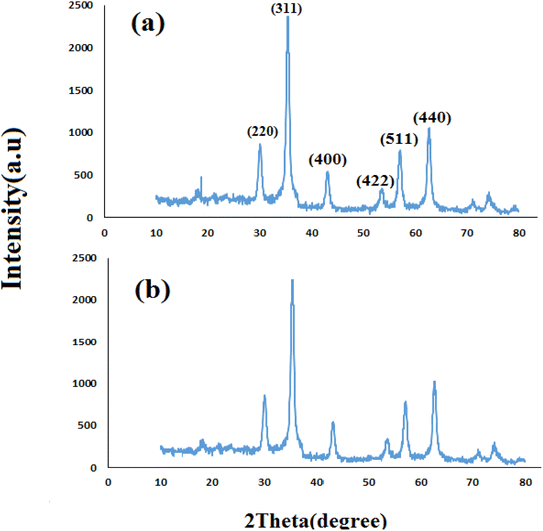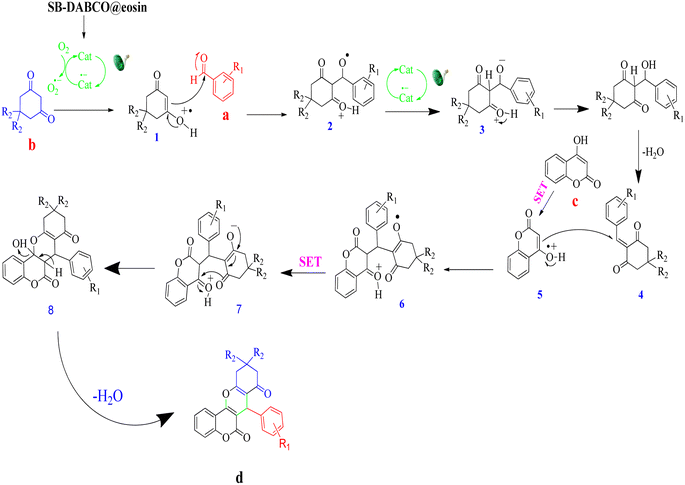 Open Access Article
Open Access ArticleCreative Commons Attribution 3.0 Unported Licence
Magnetic nanoparticle-supported eosin Y salt [SB-DABCO@eosin] as an efficient heterogeneous photocatalyst for the multi-component synthesis of chromeno[4,3-b]chromene in the presence of visible light
Mahbube Jarrahi *a,
Behrooz Maleki
*a,
Behrooz Maleki *ab and
Reza Tayebee
*ab and
Reza Tayebee a
a
aDepartment of Chemistry, School of Sciences, Hakim Sabzevari University, Sabzevar, 96179-76487, Iran. E-mail: b.maleki@umz.ac.ir
bDepartment of Organic Chemistry, Faculty of Chemistry, University of Mazandaran, Babolsar, Iran
First published on 11th October 2022
Abstract
Heterogeneous photocatalysts present a favourable procedure to realize green and eco-friendly organic reactions. We have demonstrated an SB-DABCO@eosin catalyst in a green one-pot multi-component protocol for the production of various chromeno[4,3-b]chromenes via condensation of aromatic aldehydes and dimedone under the photo-redox catalyst bearing eosin Y using visible light. The synthesized nanocatalyst was characterized using various physicochemical techniques such as FT-IR, XRD, EDX, UV-vis, SEM, TGA and DRS. The significant advantages of the present methodology include excellent yield, cost-effectiveness, easy work-up, 100% atom economy, broad substrate scope, easy separation and efficient recycling. Furthermore, the evidence showed that the investigated condensation reaction proceeds via a radical mechanism, which proved the need for reactive species such as OH˙ and ˙O2− in the photocatalytic process. In addition to the improved handling and process control, the yield of products and the rate of reactions have increased considerably in the present strategy. Reproducibility studies also guarantee good reusability and stability of the nanocatalyst for at least five runs.
1. Introduction
The development of multi-component reactions (MCRs) has attracted attention in an environment friendly pathway. Multi-component reactions merge at least three reactants in a single reaction vessel to produce a product containing most atoms of the starting materials in a convergent way. MCRs as an efficient tool in drug discovery fields and synthetic organic chemistry have gained preponderance over customary multistep reactions.1–6 MCRs possess many apparent advantages over multistep processes, such as atom economy, high efficiency, reduced waste generation, quick and simple implementation, time-saving and energy economy. Simple separation and small amounts of used solvents or chromatographic materials are other advantages of MCRs.7–9In the past few years, magnetic nanoparticles (MNPs) appeared as a new kind of semi-heterogeneous support for catalysts, and the intrinsic magnetic properties of the support allow functionally convenient separation using an external magnet. Magnetic nanoparticles are important catalysts for the synthesis of various compounds because they have a considerable advantages such as non toxicity, enhanced water solubility, elevated stability and reduced particle aggregation and reusability compared to other catalysts.10–16 Among different types of nanoparticles, iron oxide nanoparticles have been widely explored by researchers because they do not retain any magnetization when the magnetic field is removed. In fact, iron oxide nanoparticles (Fe3O4) have been widely applied due to their easy functionalization with polymers and other materials.17,18
The chromenes that are crucial oxygenated heterocyclic compounds mostly come up as an important structural component in biologically active natural compounds such as anthocyanins, alkaloids, tocopherols and flavonoids. In addition, chromene compounds have played a remarkable role in the synthesis of favorable compounds in the fields of pharmacology and drug chemistry.19–21 These compounds exhibit diverse biological activities and act as anti-cancer,22 anti-tumor,23 anti-HIV,24 anti-Alzheimer,25 anti-bacterial,26 anti-leishmanial,27 antitubercular,28 antihypertensive,29 antioxidative,30 and anti-inflammatory31 agents. Chromanes have been shown to have the ability to activate potassium channels and impede phosphodiesterase IV and dihydrofolate reductases and have been employed as colored optical lasers, pigments, fluorescence markers and potential biodegradable agrochemicals.32–35 4H-Chromenes can develop the apoptotic procedure in the cancerous cells by binding to Bcl-2 anti-apoptotic proteins and therefore show anti-cancer activity.36–39
However, in recent years, owing to the increasing attention on the organic synthesis under green chemistry, chemists redesign the synthesis methods by focusing on the visible light. Visible light has the potential to serve as an inexpensive, ubiquitous, sustainable, plentiful, unlimited, universally available source of energy as well as a nonpolluting agent for chemical reactions.40–43 However, most organic molecules cannot absorb visible wavelengths and this is one of the major obstacles in the development of photochemical processes which prompts the growth of efficient visible light photocatalysts in organic synthesis. Among the metal-free organic dyes, EY has been used as a profitable and environmentally friendly alternative in the structure of many photoreduction catalysts.44 In the mechanism for the photodegradation of organic dyes, upon irradiation with incident photons, electrons are excited to the conduction band (CB) of the photocatalyst, while holes are formed in the valence band (VB).45–47 Since many organic photocatalysts (and among that eosin Y) change their photophysical properties under the influence of acid–base equilibria, determining the actual nature of the dye used in the reaction conditions is of fundamental importance. It is able to transfer the activation energy to the reactants in chemical reactions.48 Due to its ability to absorb green light, various applications have emerged for EY as an organic photosensitizer in visible light-promoted organic synthesis.49,50 In continuation, we introduce a simple, more efficient, visible light promoted procedure for the synthesis of different substituted chromeno[4,3-b]chromene derivatives via combination of aryl aldehydes, 4-hydroxy coumarin and 1,3-cyclohexanedione in the presence of SB-DABCO@eosin as a green heterogeneous nanocatalyst under solventless conditions (Scheme 1). The present strategy promotes the cyclization of chromeno[4,3-b] chromenes via the formation of C–C and C–O bonds to obtain the products with excellent yield during a simple one-pot operation under mild reaction conditions. The extended procedure is an affordable alternative to devices involving metal base catalysts. Its atom economy, mild conditions, high convergence, near stoichiometric use of reactants without any additives and concomitant step economy in combination with their general compatibility rank it among sustainable synthetic methods.
 | ||
| Scheme 1 Multi-component reaction of aldehydes (a), cyclic 1,3-dicarbonyl (b) and 4-hydroxycoumarin (c) promoted by SB-DABCO@eosin. | ||
2. Experimental section
2.1. Materials and methods
All materials and solvents were purchased from Merck, Sigma-Aldrich, and Fluka and were employed as received without further purification. Fourier transform infrared (FT-IR) was performed in the range 400 to 4000 cm−1 (PerkinElmer) using the KBr disc technique. Morphologies of the synthesized nanomaterials were analyzed using a Quantum 2000 field emission scanning electron microscope (FESEM). 1H- and 13C-NMR spectra were recorded on a 300 MHz Bruker AVANCE III spectrometer using TMS as the internal reference. A Photonix UV-visible array spectrophotometer was used to record UV-visible spectra. Elemental analyses were carried out using a Thermo Finnigan (Flash-1112EA) microanalyzer. Energy dispersive X-ray spectroscopy (EDS, Bruker QUANTAX 200) was run with an electron probe microanalyser (JEOL JXA-8230) equipped with an energy dispersive spectrometer. Melting points were determined in open capillary tubes on Stuart BI Branstead Electrothermal IA9200 apparatus. X-ray diffraction (XRD) patterns were acquired at a scanning rate of 3° min−1 using a Philips PW1730 diffractometer at 40 keV and 30 mA for monochromatized Cu Kα radiation in the 2θ domain from 10° to 80°. Thermogravimetric analyses were performed with a TGA 92 Setaram with a heating rate of 10 °C per minute.2.2. General method for the synthesis of the Fe3O4 nanoparticles
Fe3O4 magnetic nanoparticles (MNPs) were synthesized according to a previous literature report with some modification. A mixture of 2.25 g FeCl3·6H2O and 0.9 g FeCl2·4H2O was dissolved in deionized water (40 ml) in a 200 ml flask. The solution was stirred vigorously (800 rpm) at RT for 10 min. Then, 7 ml of solution of 25% (w/w) ammonia was added into the mixture in a drop-wise manner over a 3 min period by means of a dropping funnel. The reaction system turned black quickly. The mixture of magnetite nanoparticles was stirred for 4 h at RT. The supernatant was decanted and magnetic Fe3O4 nanoparticles were collected by means of an external magnet and rinsed exhaustively with distilled water (20 ml) and ethanol (20 ml) until the pH of the solution reached 7. The washing operation was continued until the pH reached 7. Finally, the black MNPs were washed with 20 ml of acetone and dried in an oven at 50 °C.512.3. Synthesis of the Fe3O4·SiO2 nanoparticles (SMNPs)
0.25 g of Fe3O4 was added to a 100 ml balloon containing 40 ml of deionized water and 10 ml of 96% ethanol, and the contents of the balloon were sonicated for 30 min or more to disperse the nanoparticles well. We continued the irradiation process until we observed the dispersion of the nanoparticles well. Then 7 ml of ammonia was added dropwise to the contents of the 100 ml balloon in one min. This operation was performed under ultrasound radiation. In this case, it was exposed to ultrasound again for another 10 min. Then tetraethyl orthosilicate (TEOS, 4 ml) was added to the solution drop by drop under ultrasonic irradiation for 2 min. After adding all the TEOS to the 100 ml balloon, it was irradiated for another 5 min. So for all the work steps, the 100 ml balloon was inside the ultrasonic bath. After this, we took the balloon out of the ultrasonic bath and rotated it with a magnetic stirrer for 24 h at room temperature. Then, we washed and dried the sample as described for Fe3O4.522.4. Synthesis of Fe3O4@SiO2@Pr–Cl (SMNPs@Pr–Cl)
0.8 g SMNPs was added to a 50 ml balloon containing 30 ml of dried toluene and the contents of the balloon were sonicated for 30 min or more to disperse the fine nanoparticles. We continued the irradiation process until we observed the dispersion of the nanoparticles well. Then 4 ml of 3-chloropropyl trimethoxysilane was added to the 50 ml balloon by drop syringe over 2 min and allowed to disperse for another 10 min. The contents of the balloon were then removed from the ultrasonic water bath and rotated at 110 °C using a magnetic stirrer for 48 h under reflux conditions. The nanoparticles were then removed using a magnet and first washed with 10 ml of ordinary toluene, and then washed with deionized water and then ethanol, as in the above method. Finally, they were dried in an oven at a temperature of 50 °C for 4 to 5 h.532.5. Preparation of silica bonded 1,4-diazabicyclo[2.2.2]octane (SB-DABCO)
30 ml dry acetone was poured into a round-bottomed flask equipped with a refluxing condenser and 0.56 g DABCO (5 mmol) and 1 g SMNPs@Pr–Cl were added and the mixture was refluxed. After 36 h the reaction mixture was cooled at room temperature and dried under vacuum on a glass filter, and then washed with acetone, ethanol, and methanol in turn. The product obtained from this step was dried for 5 h under vacuum at 50 °C to give SB-DABCO as a white powder.542.6. Surface modification of SB-DABCO nanoparticles with eosin
The SB-DABCO@eosin nanohybrid material was obtained from the well-known wet impregnation procedure. Hence, 0.02 ml eosin was dissolved in THF. Then, nano SB-DABCO (0.5 g) was slowly added to the obtained solution for 12 h under a dark atmosphere. The resulting powder was dried at 80 °C under air for 24 h. All steps of the SB-DABCO@eosin synthesis are summarized in Scheme 2.2.7. General procedure for synthesis of substituted chromeno[4,3-b]chromene
1 mg SB-DABCO@eosin nanoparticles, 100 mg benzaldehyde (1 mmol), 162 mg 4-hydroxycoumarin (1 mmol) and 140 mg dimedone (1 mmol) were added to a 25 ml round bottom flask. The mixture was irradiated with a green light-emitting diode (λmax = 535 nm) under open air conditions at room temperature. After completion of the reaction (controlled by TLC, n-hexane![[thin space (1/6-em)]](https://www.rsc.org/images/entities/char_2009.gif) :
:![[thin space (1/6-em)]](https://www.rsc.org/images/entities/char_2009.gif) ethyl acetate, 3
ethyl acetate, 3![[thin space (1/6-em)]](https://www.rsc.org/images/entities/char_2009.gif) :
:![[thin space (1/6-em)]](https://www.rsc.org/images/entities/char_2009.gif) 1), 3 ml H2O was added to the mixture and the desired chromene product was dissolved in EtOAc. After extracting the aqueous fraction with ethyl acetate (3 × 3 ml), the obtained organic layer was dried over sodium sulfate and concentrated in vacuo. The raw accomplished product was purified through column chromatography (100–200 mesh silica gel; ethyl acetate/hexane) to supply the pure chromene. The product was confirmed by 1H and 13C NMR spectra.
1), 3 ml H2O was added to the mixture and the desired chromene product was dissolved in EtOAc. After extracting the aqueous fraction with ethyl acetate (3 × 3 ml), the obtained organic layer was dried over sodium sulfate and concentrated in vacuo. The raw accomplished product was purified through column chromatography (100–200 mesh silica gel; ethyl acetate/hexane) to supply the pure chromene. The product was confirmed by 1H and 13C NMR spectra.
2.8. Spectral NMR data selected of the prepared chromenes
3. Results and discussion
In this paper, we have tried to synthesize substituted chromeno[4,3-b]chromenes using SB-DABCO@eosin NPs. Some procedures have been reported for the production of chromeno[4,3-b]chromene derivatives via combination of arylaldehydes with 4-hydroxycoumarine and cyclic-1,3-diketone compounds in the presence of p-TSA, Fe[DS]3, [DMDBS]·2HSO4, and I2/HOAc.54–57 However, most of these techniques bear at least one of the following disadvantages: difficult and boring work-up procedures, long reaction time, high operating temperature, non-recyclable or expensive metal catalysts, moderate yields and poor selectivity, commercially unavailable compounds, corrosive and harmful organic solvents, and limited substrate scope.Therefore, it seems that the main work is to replace inefficient methods with more plausible methods based on recyclable, stable, and improved catalysts. Environmental and economic concerns have turned researchers' attention to green chemical processes in organic synthesis. In recent years, photochemical techniques, especially using visible light, have become an efficient tool for chemical reactions. The superiority of using a visible light photo redox catalyst is its ability to activate atmospheric oxygen, a natural green oxidizing agent in visible light, controlled by organic transformations involving single electron transfer (SET). Among the organic dyes of the fluorescein family, the organic dye eosin Y has found a better place in photocatalyzed organic reactions due to its better performance capacity.48
3.1. Characterization and physicochemical properties of [SB-DABCO@eosin] nanoparticles
The synthesized supported [SB-DABCO@eosin] nanocatalyst was characterized by means of XRD, UV-vis, DRS, FT-IR, SEM, TGA and EDX. The surface interaction between eosin and [SB-DABCO@eosin] can be investigated by using FT-IR and UV-vis analyses. The material was analyzed by different analytical and spectroscopic techniques. The XRD patterns of the materials reported the formation of nano sized particles. The morphology and particle size of the [SB-DABCO@eosin] NPs were further confirmed by scanning electron microscopic (SEM) study. Energy dispersive X-ray analysis through SEM obviously showed the high purity of the sample.![[thin space (1/6-em)]](https://www.rsc.org/images/entities/char_2009.gif) cos
cos![[thin space (1/6-em)]](https://www.rsc.org/images/entities/char_2009.gif) θ, λ = 0.15406 nm); here, the peak of the highest intensity (311, 2θ = 35.6) was chosen to define the diameter of the nanoparticles. Thus, the size of SMNPs@DABCO@eosin particles was attained to be ∼80 nm, in accord with the FESEM analysis.
θ, λ = 0.15406 nm); here, the peak of the highest intensity (311, 2θ = 35.6) was chosen to define the diameter of the nanoparticles. Thus, the size of SMNPs@DABCO@eosin particles was attained to be ∼80 nm, in accord with the FESEM analysis.
![[double bond, length as m-dash]](https://www.rsc.org/images/entities/char_e001.gif) C of aromatic phenyl rings, respectively, confirms the loading of EY on the SMNP@DABCO surface.65
C of aromatic phenyl rings, respectively, confirms the loading of EY on the SMNP@DABCO surface.65
3.2. Catalytic tests
To investigate the photocatalytic activity of SMNPs@DABCO@eosin, a model reaction was designed using 1 mmol benzaldehyde, 1 mmol dimedone, and 1 mmol 4-hydroxycoumarin in the presence of the photocatalyst under irradiation with LED light. The reaction mixture was magnetically stirred in an open air test tube. To derive the best reaction conditions, various parameters of condensation reaction, such as irradiation source, amount of photocatalyst, reaction time, type of solvents and temperature, were optimized.| Entry | Light source | Light specification | SMNPs@DABCO@eosin | Time (h) | Yield (%) |
|---|---|---|---|---|---|
| a Reaction conditions: benzaldehyde (1 mmol), 4-hydroxycoumarin (1 mmol), dimedone (1 mmol), SMNPs@DABCO@eosin (1 mg), solvent free, room temperature, open atmosphere. | |||||
| 1 | Dark | — | 0.001 | 2 | 15 |
| 2 | White LED | 20 × 1 W | 0.001 | 2 | 19 |
| 3 | Blue | 2.5 W, λ = 431 nm | 0.001 | 2 | 47 |
| 4 | Red | 2.5 W, λ = 695 nm | 0.001 | 2 | 44 |
| 5 | Green | 2.5 W, λ = 535 nm | 0.001 | 2 | 62 |
| 6 | Violet | 2.5 W, λ = 455 nm | 0.001 | 2 | 40 |
| Entry | SMNPs@DABCO@eosin (g) | Solvent | Time (min) | Yieldb (%) |
|---|---|---|---|---|
| a Reaction conditions: benzaldehyde (1 mmol), 4-hydroxycoumarin (1 mmol), dimedone (1 mmol), SMNPs@DABCO@eosin (0.004 g), room temperature, open atmosphere, green LEDs (2.5 W, λ = 535 nm).b Isolated yield of product. | ||||
| 1 | 0.004 | — | 50 | 98 |
| 2 | 0.004 | H2O | 50 | 86 |
| 3 | 0.004 | Toluene | 50 | 62 |
| 4 | 0.004 | Ethanol | 50 | 84 |
| 5 | 0.004 | CH3CN | 50 | 70 |
| Entry | SMNPs@DABCO@eosin (g) | Temperature (°C) | Time (min) | Yieldb (%) |
|---|---|---|---|---|
| a Reaction conditions: benzaldehyde (1 mmol), 4-hydroxycoumarin (1 mmol), dimedone (1 mmol), SMNPs@DABCO@eosin (0.004 g), solvent free, open atmosphere, green LEDs (2.5 W, λ = 535 nm).b Isolated yield of product. | ||||
| 1 | 0.004 | 25 | 50 | 98 |
| 2 | 0.004 | 55 | 50 | 88 |
| 3 | 0.004 | 82 (reflux) | 50 | 90 |
In a common photocatalytic system, choosing an appropriate electron carrier is necessary to facilitate effective transfer of charge carriers and enhance the stability of the photocatalyst. Fe3O4·SiO2@DABCO (SMNPs@DABCO) and eosin fragments absorb sufficient energy to produce electron–hole pairs upon exposure to the green LEDs. The results of this study show that light absorption remarkably increased with the as-prepared hierarchical SMNPs@DABCO@eosin nanocomposite. The photoinduced electrons in SMNPs@DABCO CB tend to shift toward the interface of the heterojunction and endeavor to combine with the holes of eosin (EY) VB. Thus, SMNPs contribute to the process and bridges between the DABCO and EY, enhancing the combination rate. Therefore, the recombination rate of charge carriers drastically suppresses within SMNPs@DABCO and EY, leading to accumulation of electrons in EY CB and holes in the VB of SMNPs@DABCO. Ultimately, the accumulated electrons with strong reducibility would reduce O2 to ˙O2− (Scheme 3).74
| Catalyst | Time (min) | Temp (°C) | Solvent | Yield (%) | Ref. |
|---|---|---|---|---|---|
| a Benzaldehyde was used in all cases. | |||||
| SMNPs@DABCO@eosin (4 mg) | 50 | r.t. | — | 98 | This work |
| Eosin Y (2 mol%) | 210 | r.t. | CH3CN | 77 | 19 |
| Fe3O4@SiO2@(CH2)3OMoO3H (2 mg) | 45 | 80 | — | 90 | 75 |
| t-ZrO2 np (10 mol%, 12.3 mg) | 30 | 80 | H2O (5 ml) | 91 | 76 |
| CuFe2O4@SO3H (0.05 g) | 150 | 70 | EtOH | 90 | 77 |
| Fe(DS)3 (10 mol%) | 120 | 70 | H2O | 87 | 57 |
| Entry | Aldehyde | Dimedone | Product | Yield (%) | M.p |
|---|---|---|---|---|---|
| Found, reported78–80 | |||||
| a Reaction conditions: benzaldehyde (1 mmol), 4-hydroxycoumarin (1 mmol), dimedone (1 mmol), SMNPs@DABCO@eosin (0.004 g), solvent free, room temperature, open atmosphere, green LEDs (2.5 W, λ = 535 nm), time: 50 min. | |||||
| 1 |  |
 |
 |
90 | 223–224, 220–222 |
| 2 |  |
 |
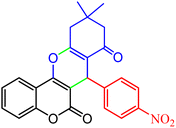 |
96 | 209–211, 208–210 |
| 3 |  |
 |
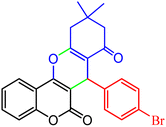 |
76 | 227–229, 228–230 |
| 4 |  |
 |
 |
75 | 190–191, 187–189 |
| 5 |  |
 |
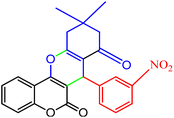 |
79 | 233–234, 230–232 |
| 6 |  |
 |
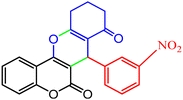 |
77 | 220–222, 218–220 |
| 7 |  |
 |
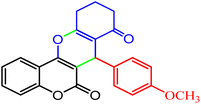 |
78 | 196–198, 196–197 |
3.3. Suggesting a plausible reaction pathway
A feasible mechanism for the generation of chromeno[4,3-b]chromene by SMNPs@DABCO@eosin is given in Fig. 13. It is proposed that the photoredox catalyst eosin Y is converted to excited state eosin Y* upon visible light irradiation, and then this eosin Y* undergoes reductive quenching by 1,3-dicarbonyl compound (b) to create the radical cation (1) and converts to the radical anion of eosin Y. Now this radical cation (1) is reacted with aldehyde (a) to form (2), and simultaneously eosin Y undergoes single electron transfer (SET) to produce compound (2) to (3). Dehydration of the compound (3) produces the β-dicarbonyl-enone (4) which can act as a Michael acceptor. Again 4-hydroxycoumarin (c) converts into a radical cation (5) by the photo-redox catalyst eosin Y via the single electron transfer (SET), and now this radical cation (5) undergoes Michael type addition reaction with β-dicarbonyl-enone (4) and furnishes a compound (6). At the same time, eosin Y undergoes single electron transfer (SET) to convert (6) into (7). Finally (7) on a simple dehydration reaction leads to the targeted molecule (d).814. Conclusions
In conclusion, we have successfully introduced an impressive route for the production of chromeno[4,3-b] chromene in the presence of a metal free catalyst under green LED irradiation. Eosin Y as a low cost and readily available photoredox catalyst has surely proven to be a superior green replacing reagent. We are very hopeful that this methodology will play a fundamental role in medicinal chemistry, natural product chemistry and organic synthesis by serving as a robust and economical alternative way to synthesize target molecules.Conflicts of interest
There are no conflicts to declare.Acknowledgements
The work was supported by Hakim Sabzevari University.References
- D. Insuasty, J. Castillo, D. Becerra, H. Rojas and R. Abonia, Molecules, 2020, 25(3), 505 CrossRef PubMed.
- C. G. Neochoritis, T. Zarganes-Tzitzikas, K. Katsampoxaki-Hodgetts and A. Dömling, Kinderleicht, J. Chem. Educ., 2020, 97(10), 3739–3745 CrossRef CAS PubMed.
- S. Zhi, X. Ma and W. Zhang, Org. Biomol. Chem., 2019, 17(33), 7632–7650 RSC.
- C. S. Graebin, F. V. Ribeiro, K. R. Rogério and A. E. Kümmerle, A Review, Curr. Org. Synth., 2019, 16(6), 855–899 CrossRef CAS PubMed.
- R. C. Cioc, E. Ruijter and R. V. Orru, Green Chem., 2014, 16, 2958–2975 RSC.
- M. B. Gawande, V. D. Bonifácio, R. Luque, P. S. Branco and R. S. Varma, Chem. Soc. Rev., 2013, 42, 5522–5551 RSC.
- A. R. Salih and Z. A. K. Al-Messri, Eurasian Chem. Commun., 2021, 3, 533–541 CAS.
- M. Nikpassand and L. Z. Fekri, Chem. Methodol., 2020, 4, 437–446 CrossRef CAS.
- E. Haddazadeh and M. K. Mohammadi, Chem. Methodol., 2020, 4, 324–332 Search PubMed.
- S. Shylesh, V. Schnemann and W. R. Thiel, Angew. Chem., Int. Ed., 2010, 49, 3428–3459 CrossRef CAS PubMed.
- R. Hudson, Y. Feng, R. S. Varma and A. Moores, Green Chem., 2014, 16, 4493–4505 RSC.
- M. B. Gawande, P. S. Branco and R. S. Varma, Chem. Soc. Rev., 2013, 42, 3371–3393 RSC.
- S. Sajjadifar, I. Amini, S. Habibzadeh, G. Mansouri and E. Ebadi, Chem. Methodol., 2020, 4, 623–634 CAS.
- A. H. Karimi, A. Hekmat-Ara, A. Zare, M. Barzegar, R. Khanivar and M. Sadeghi-Takallo, Eurasian Chem. Commun., 2021, 3, 360–368 CAS.
- S. A. M. Ziabari, M. Babamoradi, Z. Hajizadeh and A. Maleki, Eurasian Chem. Commun., 2020, 2, 456–464 CrossRef CAS.
- H. Aghahosseini and A. Ramazani, Eurasian Chem. Commun., 2020, 2, 410–419 CrossRef CAS.
- E. M. Materón, C. M. Miyazaki, O. Carr, N. Joshi, P. H. S. Picciani, C. J. Dalmaschio, F. Davis and F. M. Shimizu, Applied Surface Science Advances, 2021, 6, 100163 CrossRef.
- H. Su, M. Yang, L. Zhao, Sh. Yao, Q. Geng, L. Wang and G. Li, Eur. Polym. J., 2022, 177, 111476 CrossRef CAS.
- A. K. Sharma, J. Tiwari, D. Jaiswal, S. Singh, J. Singh and J. Singh, Curr. Organocatal., 2019, 6, 222–230 CrossRef CAS.
- R. Tayebee, A. Pejhan, H. Ramshini, B. Maleki, N. Erfaninia, Z. Tabatabaie and E. Esmaeili, Appl. Organomet. Chem., 2018, 32(1), 3924 CrossRef.
- F. Javadi and R. Tayebee, Iran. J. Catal., 2017, 7(4), 283–292 CAS.
- S. F. Razavi, M. Khoobi, H. Nadri, A. Sakhteman, A. Moradi, S. Emami, A. Foroumadi and A. Shafiee, Eur. J. Med. Chem., 2013, 64, 252–259 CrossRef CAS PubMed.
- M. Suzuki, K. Nakagawa-Goto, S. Nakamura, H. Tokuda, S. L. Morris-Natschke, M. Kozuka, H. Nishino and K. H. Lee, Pharm. Biol., 2006, 44, 178–182 CrossRef CAS.
- Z. Q. Xu, M. G. Hollingshead, S. Borgel, C. Elder, A. Khilevich and M. T. Flavin, Bioorg. Med. Chem. Lett., 1999, 9, 133–138 CrossRef CAS.
- C. Bruhlmann, F. Ooms, P. Carrupt, B. Testa, M. Catto, F. Leonetti, C. Altomare and A. Cartti, J. Med. Chem., 2001, 44, 3195–3198 CrossRef CAS PubMed.
- S. Emami, A. Foroumadi, M. A. Faramarzi and N. Samadi, Arch. Pharm., 2008, 341, 42–48 CrossRef CAS PubMed.
- L. Firoozpour, N. Edraki, M. Nakhjiri, S. Emami, M. Safavi, S. K. Ardestani, M. Khoshneviszadeh, A. Shafiee and A. Foroumadi, Arch. Pharmacal Res., 2012, 35(12), 2117–2125 CrossRef CAS PubMed.
- R. K. Nimesh, D. H. Dhaval, T. M. Prashant and K. P. Saurabh, Med. Chem. Res., 2011, 20, 854–864 CrossRef.
- A. Amr, M. Abdalla, S. Essaouy, M. Areef, M. Elgamal, T. Nassear and A. Haschich, Russ. J. Gen. Chem., 2017, 87, 1826–1833 CrossRef CAS.
- S. W. Ng, L. H. Chung, C. F. Yeung, H. S. Lo, H. L. Shek, T. S. Kang, C. H. Leung, D. L. Ma and C. Y. Wong, Chem.–Eur. J., 2018, 24, 1779–1783 CrossRef CAS PubMed.
- K. Nitin, K. Sushil, G. Himanshu and P. K. Sharma, WRJB, 2012, 1, pp. 1–5 Search PubMed.
- R. O. S. Kitamura, P. Romoff, M. C. M. Young, M. J. Kato and J. H. G. Lago, Phytochemistry, 2006, 67, 2398–2402 CrossRef PubMed.
- N. Thomas and S. M. Zachariah, Asian J. Pharm. Clin. Res., 2013, 6, 11–15 CAS.
- M. K. Hussain, M. F. Khan, S. Khatoon, A. G. Al-Sehemi and M. Saquib, Chromenes: Phytomolecules with Immense Therapeutic Potential, Springer, Singapore, 2020, pp. 185–204 Search PubMed.
- V. Raj and J. Lee, Front. Chem., 2020, 8, 623 CrossRef CAS PubMed.
- M. Mahdavi, J. Davoodi, M. R. Zali and A. Foroumadi, Biomed. Pharmacother., 2011, 65, 175–182 CrossRef CAS PubMed.
- J. L. Wang, D. Liu, Z.-J. Zhang, S. Shan, X. Han, S. M. Srinivasula, C. M. Croce, E. S. Alnemri and Z. Huang, Proc. Natl. Acad. Sci., India, 2000, 97, 7124–7129 CAS.
- S. A. Patil, J. Wang, X. S. Li, J. Chen, T. S. Jones, A. Hosni-Ahmed, R. Patil, W. L. Seibel, W. Li and D. D. Miller, Bioorg. Med. Chem. Lett., 2012, 22, 4458–4461 CrossRef CAS PubMed.
- A. M. Shestopalov, Y. M. Litvinov, L. A. Rodinovskaya, O. R. Malyshev, M. N. Semenova and V. V. Semenov, ACS Comb. Sci., 2012, 14, 484–490 CrossRef CAS PubMed.
- S. K. Sahoo, Renew. Sust. Energ. Rev., 2016, 59, 927–939 CrossRef.
- B. Li, R. Tayebee, E. Esmaeili, M. S. Namaghi and B. Maleki, RSC Adv., 2020, 10(67), 40725–40738 RSC.
- M. Hricovíni, J. Asher and M. Hricovíni, RSC Adv., 2020, 10(10), 5540–5550 RSC.
- S. Aguado, L. Casarrubios, C. R. de Arellano and M. A. Sierra, RSC Adv., 2020, 10(50), 29855–29867 RSC.
- Y. Zhang, C. Ye, S. Li, A. Ding, G. Gu and H. Guo, RSC Adv., 2017, 7, 13240–13243 RSC.
- Y. Chiu, T. Chang, Ch. Chen, M. Sone and Y. Hsu, Catalysts, 2019, 9, 430 CrossRef CAS.
- M. Fang, C. Tsao and Y. Hsu, J. Phys. D: Appl. Phys., 2020, 53, 143001 CrossRef CAS.
- Y. Chen, Y. Wang, H. Moon, K. Yong and Y. Hsu, RSC Adv., 2021, 11, 12288–12305 RSC.
- M. Majek, F. Filace and A. J. von Wangelin, Beilstein J. Org. Chem., 2014, 10, 981–989 CrossRef PubMed.
- V. Srivastava and P. P. Singh, RSC Adv., 2017, 7, 31377–31392 RSC.
- S. Yadav, M. Srivastava, P. Rai, B. P. Tripathi, A. Mishra, J. Singh and J. Singh, New J. Chem., 2016, 40, 9694–9701 RSC.
- M. C. Mascolo, Y. Pei and T. A. Ring, Materials, 2013, 6, 5549–5567 CrossRef CAS PubMed.
- Q. Zhang, H. Su, J. Luo and Y. Wei, Catal. Sci. Technol., 2013, 3, 235–243 RSC.
- A. A. Elmekawy, J. B. Sweeney and D. R. Brown, Catal. Sci. Technol., 2015, 5, 690–696 RSC.
- A. Hasaninejad, M. Shekouhy, N. Golzar, A. Zare and M. M. Doroodmand, Appl. Catal., A, 2011, 402, 11–22 CrossRef CAS.
- X. J. Sun, J. F. Zhou and S. J. Zhi, Synth. Commun., 2012, 42, 1987–1994 CrossRef CAS.
- H. Anaraki-Ardakani, R. Ghanavatian and M. Akbari, World Appl. Sci. J., 2013, 22, 802–808 CAS.
- K. Pradhan, S. Paul and A. R. Das, Tetrahedron Lett., 2013, 54, 3105–3110 CrossRef CAS.
- M. A. Nasseri, B. Zakerinasab and M. M. Samieadel, RSC Adv., 2014, 4, 41753–41762 RSC.
- X. Zhong, W. T. Wu, H. N. Jie, W. Y. Tang, D. Y. Chen, T. Ruan and H. P. Bai, RSC Adv., 2020, 10, 38024 RSC.
- E. Koushki, RSC Adv., 2021, 11, 23390–23399 RSC.
- L. Liu, E. Koushki and R. Tayebee, J. Mol. Liq., 2021, 330, 115542 CrossRef CAS , ISSN 0167-7322..
- H. A. Doost, A. Ghasedi and E. Koushki, J. Mol. Liq., 2021, 323, 115074 CrossRef CAS , ISSN 0167-7322..
- S. Luo, X. Zheng, H. Xu, X. Mi, L. Zhang and J.-P. Cheng, Adv. Synth. Catal., 2007, 349, 2431–2434 CrossRef CAS.
- C. Dálaigh, S. A. Corr, Y. Gunko and S. J. Connon, Angew. Chem., Int. Ed., 2007, 46, 4329–4332 CrossRef PubMed.
- Z. Jalili, R. Tayebee and F. M. Zonoz, RSC Adv., 2021, 11(29), 18026–18039 RSC.
- R. Gupta, M. Yadav, R. Gaur, G. Arora, P. Rana, P. Yadav, A. Adholeya and K. Sharma, ACS Omega, 2019, 4, 21529–21539 CrossRef CAS PubMed.
- A. Rostami, Y. Navasi, D. Moradi and A. Ghorbani-Choghamarani, Catal. Commun., 2014, 43, 16–20 CrossRef CAS.
- S. Naraginti, Y. Li, Y. Wu, C. Zhang and A. R. Upreti, RSC Adv., 2016, 6, 87246 RSC.
- X. Zheng, J. Yuan, J. Shen, J. Liang, J. Che, B. Tang, G. He and H. Chen, J. Mater. Sci.: Mater. Electron., 2019, 30, 5986–5994 CrossRef CAS.
- R. K. Sharma, B. Arora, S. Sharma, S. Dutta, A. Sharma, S. Yadav and K. Solanki, Mater. Chem. Front., 2020, 4, 605–620 RSC.
- Z. Yin, M. Han, Z. Hu, L. Feng, Y. Liu, Z. Du and L. Zhang, Chem. Eng. J., 2020, 390, 124532 CrossRef CAS.
- Y. Lin, C. P. Yang, Q. Y. Niu and S. L. Luo, Adv. Funct. Mater., 2022, 32, 2108814 CrossRef CAS.
- Y. Lin, X. Wu, Y. Han, Ch. Yang, Y. Ma, Ch. Du, Q. Teng, H. Liu and Y. Zhong, Appl. Catal., B, 2019, 258, 117969 CrossRef CAS.
- C. Liu, S. Abbaspour, M. Rouki, R. Tayebee, M. Jarrahi and E. E. Shahri, Appl. Organomet. Chem., 2022, 36(11), e6878 CAS.
- F. Khosravian, B. Karami and M. Farahi, New J. Chem., 2017, 41, 11584–11590 RSC.
- A. Saha, S. Payra and S. Banerjee, RSC Adv., 2015, 5, 101664–101671 RSC.
- S. Vajar and M. Mokhtary, Polycyclic Aromat. Compd., 2019, 39, 111–123 CrossRef CAS.
- H. Emtiazi and M. A. Amrollahi, S. Afr. J. Chem., 2014, 67, 175–179 Search PubMed.
- Y. K. Al-Majedy, A. A. Al-Amiery, A. A. H. Kadhum and A. B. Mohamad, Biomed Res. Int., 2016, 2016, 5891703 Search PubMed.
- R. Motamedi, S. Baghbani and F. F. Bamoharram, Synth. Commun., 2012, 42(11), 1604–1612 CrossRef CAS.
- B. Maleki, M. Chahkandi, R. Tayebee, S. Kahrobaei, H. Alinezhad and S. Hemmati, Appl. Organomet. Chem., 2019, 33, 5118 CrossRef.
| This journal is © The Royal Society of Chemistry 2022 |

